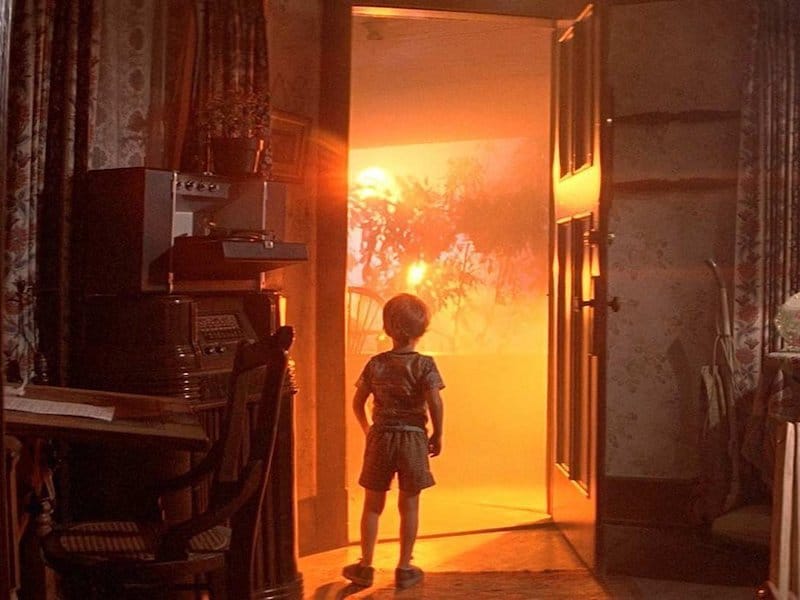
The Wild Child (1970)
Francois Truffaut had done some acting before his appearance in CE3K, but he’d only really played a major credited character in two of his recent features. In 1973’s Day for Night he’s the director of the film within the film that’s being made. Apparently he used a trick while working for Spielberg that he features in his own film, one for actors having trouble with the dialogue where they get a kind of cue card pinned to another actor’s shirt. And in this earlier film based on another strange phenomenon, Truffaut co-stars as a doctor studying the title character, a feral boy who’d lived his first 12 years without human contact.
Spielberg cast his fellow filmmaker specifically because of his performance in The Wild Child. He said (quoted in Ray Morton’s book of the making of CE3K), “I felt that he was a tremendous human presence in that film…he just radiated so much compassion. And I felt that, rather than just putting the face of government on this movie…I wanted the fact that led the way to be extremely charitable and kind and optimistic…I needed a man who would have the soul of a child, someone kindly, warm, who completely accepts the extraordinary, the irrational.” And in McBride’s biography he’s quoted saying, “There was a child inside Francois Truffaut. Watching him perform in his films The Wild Child and Day for Night, I saw that child…That was the spirit I wanted for Lacombe.”
Chariots of the Gods (1970)
Unlike most UFO cinema before CE3K, Spielberg’s movie has a kind of New Age feel. And with its global scope and dealing with past abductions, it has a more historical feel, as well, hinting that the aliens had been around for a long time and had a rather spiritual connection for whole cultures and also individuals like Roy. The India sequence (which was actually done for business reasons by Columbia Pictures) gives the aliens in CE3K an especially divine quality.
One potential influence on this different take on UFOs and aliens in cinema might have been the 1968 book “Chariots of the Gods?: Unsolved Mysteries of the Past,” written by Erik von Daniken. Quickly adapted into this Oscar-nominated German documentary by Harald Reinl, it popularized the idea of aliens having been visiting for millennia, influencing religions and myths and civilizations and more. Originally released in the US as the reworked TV movie In Search of Ancient Astronauts, the doc was also followed in 1976 by the same director’s Mysteries of the Gods.
The Devil’s Triangle (1974)
This week you get two documentary recommendations. Chariots of the Gods gives you some background on the idea of aliens among us or at least having been here before. For the background on some of the abductees, though, you need a film about the Bermuda Triangle, or Devil’s Triangle (it’s no wonder they’d be dropped off at Devil’s Tower). Director Richard Winer based this mid-length doc on his own book of the same name, and both helped to popularize the phenomenon of people and whole ships and groups of planes going missing in an area of the North Atlantic.
References to the Bermuda Triangle in CE3K include the famous Flight 19 that disappeared in December 1945. The five bombers are depicted as being found at the start of Spielberg’s movie, with their pilots being among those released from the Mothership at the climax. There’s also the SS Cotopaxi, which was lost in 1925. That’s the cargo ship found in the Gobi Desert with no rational reason for how it got there. Spielberg only added this stuff in later drafts of his script because the idea of UFOs/aliens being involved in the Bermuda Triangle disappearances was fresh on people’s minds in the mid-’70s thanks to Winer’s Vincent Price-narrated doc, which first aired on ABC.
The UFO Incident (1975)
For UFO and alien buffs, Spielberg’s attention to genuine lore surrounding abductions, sightings, etc. is appreciated. His aliens are based on “the greys,” extraterrestrials described in numerous abductee and encounter accounts, including that of Betty and Barney Hill. Reports of their famous 1965 incident were probably the greatest boost in awareness of this description of aliens. While the first appearance in film of aliens that look like “the greys” is likely with Edgar G. Ulmer’s 1951 sci-fi/horror feature The Man from Planet X, the first intended to reflect real accounts had to be this TV movie depicting the Hills’ story.
Estelle Parsons and James Earl Jones, both of them recent Oscar nominees (Parsons won the first of her two nominations), star in the production, originally broadcast on NBC. So this wasn’t just some schlocky affair. Still, its effects budget couldn’t have been anything like Spielberg’s, and the aliens here just look like guys wearing cheap rubber masks. The Hills were pretty well-known to Americans thanks to this TV movie, if not already from the book it’s based on and their initial story. So one could, as Spielberg does in a 1978 Rolling Stone interview, reference them casually when discussing aliens:
“They were always the same, based on reports, on third-kind eyewitness encounters over the years,” he says. “I mean, Aborigines who’ve had third kind encounters described the same features as Betty and Barney Hill from New Hampshire, and people in France. Russians. All describe the same: the spindly arms, the four-foot stature, the waif-like eyes. In third kind encounters, it’s all the same. That’s one of the things that perplexed me.”
Related Topics: Close Encounters of the third Kind, Movie DNA, Steven Spielberg
